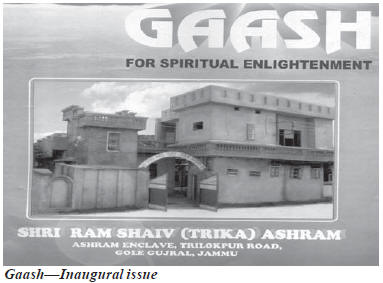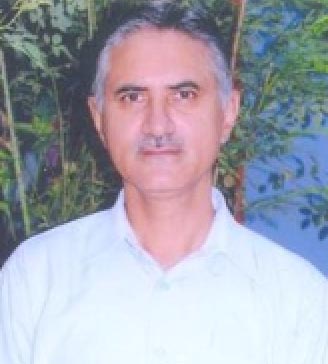Saiva Saints
of 19th-20th Century Kashmir
By Dr. R.K. Tamiri
For
over twelve centuries
Trika Shaivism has remained a dominant creed
in Kashmir, influencing almost
every aspect of social life of
Hindu society of Kashmir. Its
rich legacy reflected in philosophy,
folklore, aesthetics, literature,
art and architecture, rituals,
place names, surnames,
even food and dress etc. is a
proof of it.
Philosopher Vasgupta was
the first to enunciate principles
of Kashmir Saivism to fashion
an ideological response to
Buddhism. The latter had held
strong sway in post-Kushan
Kashmir. Further contours
were defined by Bhatta Kallata,
Somananda and Utpaldeva. It
was Abhnavupta who codified
it as a complete world-view.
Kashmir Saivism to fashion
an ideological response to
Buddhism. The latter had held
strong sway in post-Kushan
Kashmir. Further contours
were defined by Bhatta Kallata,
Somananda and Utpaldeva. It
was Abhnavupta who codified
it as a complete world-view.
Such outstanding scholars -
Kshemaraja, Jayaratha,
Yograja, Madhuraja, Vardaraja
etc. wrote exchaustive commentaries
to make the tenets
of Kashmir Saivism intelligible
to the people. The last in this
line was Sivopadhyaya, the
author of commentary on
Vijnan Bhairava. He lived in
18th century, in the times of
Pathan Governor Sukhjiwan
Mall.
The place of pride, however,
goes to Lalla Yogeshwari,
the great 14th Century Saintpoetess
of Kashmir, who
brought Saivite message down
to the common man, from elitist
discourse. She has been
described as a Saivite Yogini,
who used the native language
and idiom to versify the Saiva
ideals. For this remarkable contribution
she has not only been
hailed as a great Saiva scholar
but also as one to whom
Kashmiris feel indebted for
giving life to Kashmiri language.
Her appeal transcended
class and community.
How has Kashmir Saivism
been able to maintain continuity,
despite adverse conditions,
with its appeal remaining all
pervasive? The corpus of Saiva
literature, both historical and
contemporary, is silent about
the institutions that perpetuated
Saiva creed over centuries.
Unfortunately, philosophy
of Saivism rather than its
social dimensions have remained
the main focus of the
native as well as foreign scholarship.
However, there are
stray references which indicate
that Saivite tradition found its
continuity through the institution of
mathika,
a Saivite
asrama. Mathika maintained and
established the traditions of a
guru-sisya (guru-parampara).
As per Dr VN Drabu, the author
of Saivagamas,
the mathika
accommodated
the viewpoints of
its different sisyas
who came
from all orders and varnas
of
society. These mathikas
preserved
the unbroken tradition of
the guru
and the disciple.
Madhuraja, the famous South
Indian Saivite, who visited
Abhinavgupta's
asrama,
has
left for us an interesting account
of this in his
Gurunath
Pramarsa.
It is likely, on the basis of circumstantial
evidence, that at no
time in history the institutions
that perpetuated the Saivite tradition
faced collapse. It is safe
to speculate that these institutions
changed forms and methods
of functioning from time to
time, depending upon the exigencies
required. Saint-poetess
Lalleshwari did not turn to
Saivism just because she was
wronged by her in-laws. This
hagiography has sought to suppress
the well-organised gurusisya
parampara which functioned
so well, where even common
woman had all the freedom
to take to Sanskrit and philosophy.
Had
guru-sisya
parampara
been dead during late medieval
times how could social milieu
give birth to
Sivopadhyaya?
Bhaskar Razdan, to whom we
owe first written collection of
Lalleshwari's verses, lived in 17th
Century. He was an ardent
Shaivite and a good Sanskrit
scholar. So was his grandson
Manas Ram. Balak Bhat of Bulbul
Lankar, who lived during Pathan
rule, had written a commentary
on Sivasutravali of Utpaldeva.
Anand Pandit, the great scholar
of Grammar, Rhetoric, Sanskrit
etc. was a direct descendant of
Sivopadhyaya. He was a resident
of Purushyar and lived in
first half of 20th Century.
The intention in taking recourse
to history is to emphasise
that Saiva institutions of
19th and 20th Century Kashmir
did not emerge all of a sudden.
They represented the organic
continuity of Saiva Institutions
through history. Some day researchers
might be able to lay
hand on the direct evidence regarding
Saiva Institutions of turbulent
medieval lines.
Gaash, the inaugural issue
brought out by Shri Ram (Trika)
Shaiv Ashram (Fatehkadal), Gole
Gujral, Jammu to commemorate
the 150th birth anniversary of the
great Saiva Saint-Scholar, Swami
Ramjoo, has filled an important
gap in historiography of Kashmir
Shaivism. It is a pioneering
effort on two counts. One, it
shifts the focus from philosophical
to social dimensions of Kashmir
Saivism. Secondly, for the
first time an attempt has been
made to present rich biographical
material about Saiva saints of
19th and 20th century. The editor,
Shri Upender Ambardar, an
ace researcher himself has done
a commendable job to reach out
to the families associated with
these great saints.
Gaash carries four articles on
Swami Ramji, two on Swami
Govind Kaul Jalali, one each on
Swami Vidyadhar Ji, Swami Gash
Kaul Jalali and Late Kashi Nath
Kaul. The other 4-5 write-ups
deal with philosophical aspects
about which there is no dearth
of literature. There are also excellent
photographs of the Saints
in this magazine. The Ram Shaiv
(Trika) Ashram was established
in 1884.
The popularity of these Saiva
Saints was partly due to their
teaching of Saivism and partly
because of
Tantra
Vidhya that
they practised. The miracles attributed
to these saints reflect
their mastery over Tantra
Vidhya. Common people felt relieved
while bringing their tales
of woe to these saints. Others
flocked to the ashram
saints in
search of spiritual quest.
Swami Ram Ji was succeeded
by Swami Mehtab Kak. After him
Swami Govind Kaul Jalali took
the responsibility of running
Fatehkadal Ashram. He was succeeded
by Late Kashi Nath Kaul.
Presently, it is headed by Mrs
Chand Rani Wangnoo, the tradition
of teaching of Shaivism
continues under the guidance of
Sh. Vishnath Jyotishi and Bansi
Lal Wangnoo. Among illustrious
disciples of Swami Ram Ji were
Mehtab Kak, Swami Vidyadar Ji,
Narayan Joo Jyotishi, the great
Sanskrit scholar and Raj Purohit
of Maharaja Pratap Singh, the
three Jalali brothers - Aftab
Kaul, Govind Kaul and Gash
Kaul, Sudhamaji Miskeen, Lal
Kaul, father of Prof. Jaya Lal
Kaul, Thokur Kaul Bhan (Grandfather
of Prof. TN Bhan). The latter
had compiled biography of
his Guru in Persian verse.
It was at Swami Ram Ji's insistence
that Pt. Narayan Das
Raina named his son as
Lakshman, the former initiated
him into Saivism. His outstanding
contribution to Kashmir
Saivism has been in making
Kashmir Saivism known internationally.
At Ramji's advice
Mehtab Kak was appointed his
tutor. Swami Vidyadhar Ji took
Saivism to rural masses through
his extensive travels in the countryside.
His disciples included
Mahadev Kak, Dr Srikanth,
Anand Joo Hashia, Mrs.
Tarawati of Tral etc. His
ashram
is presently located at Paloura,
in Srinagar it functioned from
Karan Nagar.
The best read disciple of
Swami Rami Ji was Swami Govind
Kaul Jalali. His disciples were
Tarachand, Kashi Nath Kaul, JN
Bazaz, BN Nazir, Arzan Nath, Dr
TN Ganjoo, Prem Nath Nehru,
Nath Ji Dral, Ramchand Jalla. Dr.
Jaidev Singh, the renowned
translator of Pratibhijna and
Shaiva Sutra into English, enjoyed
close relationship with
Swami Govind Kaul Ji.
The essays in
Gaash
do not
tell us much about Lala Joo
Kokroo, Mansa Ram Monga,
Ishwar Joo Shair, Ishwar Joo
Handoo - the illustrious predecessors
of Swami Ram Ji. All of
them had played good role in
grooming him up. There are no
references to such great Saiva
scholars of 20th Century - Ram
Joo Saudagar, Janki Nath Bakshi,
Moshar Razdan, Ramjoo
Kokiloo, Pt. Shivji Bhat (fatherin-
law of PN Bazaz) etc. Ramjoo
Saudagar was trained in Saivism
by Swami Ramjoo, Initially,
Swami Ramji had asked Ramjoo
Saudagar to teach Saivism to
Swami Lakshman Joo. Somehow,
Lakshman Joo felt more comfortable
with Mehtab Kak. Since
later was not good in teaching,
the job was ultimately assigned
to Pt. Moshar Razdan of Bana
Mohalla. Late Moshar Razdan
was a Saivite scholar par excellence.
JC Chatterji, the former
Director Archeology and celebrated
author of
Kashmir
Saivism learnt Saivism through
Moshar Razdan. Moshar
Razdan's brother Pt. Mukand
Ram Razdan too was a great
scholar. Pt. Visheshwar
Razdan, son of Pt. Mukand
Razdan, died quite young, he
too was a great scholar of Sanskrit
and Shaivism.
Pt. Ramjoo Kokiloo and Pt.
Janki Nath Bakshi were initiated
into Saivism by Sh. Ramjoo
Saudagar. Pt. JN Bakshi retired
as DIG customs, his knowledge
of Sanskrit, Persian and English
was superb. Ramjoo Kokiloo
taught Shaivism at his house
in evening mehfils. These were
attended by Har Lal Zutshi,
Chief Accountant of Food and
Supplies Deptt., Dam Kak,
Mahadev Joo, Vish Kak etc.
In
Gaash
there are
conflicting
versions on how Swami
Ram Joo's wife and his son
died. Sh SK Mam in his essay
'Swami Ramjee - A Perfect
Siddha', says Swami
Vivekananda met S w a m i
Ramji at his Fatehkadal Ashram
in 1892. As per Pt. Dina Nath
Yaksha Swami Vivekananda did
not meet Swami Ji. He quotes
Vivekananda (In Eastern and
Western description) 'I missed
to see Fatehkadal Saint. Swami
Ramjoo did not go to meet anybody.
He had free will, was
Swantantra Vadak unlike
Paramahans who addressed
with emotions'.









 Kashmir Saivism to fashion
an ideological response to
Buddhism. The latter had held
strong sway in post-Kushan
Kashmir. Further contours
were defined by Bhatta Kallata,
Somananda and Utpaldeva. It
was Abhnavupta who codified
it as a complete world-view.
Kashmir Saivism to fashion
an ideological response to
Buddhism. The latter had held
strong sway in post-Kushan
Kashmir. Further contours
were defined by Bhatta Kallata,
Somananda and Utpaldeva. It
was Abhnavupta who codified
it as a complete world-view.




No one has commented yet. Be the first!